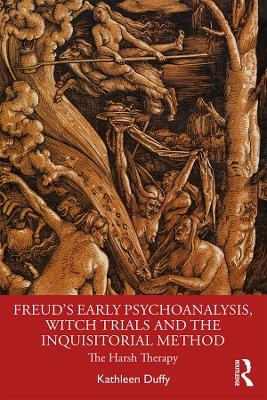
Freud's Early Psychoanalysis, Witch Trials and the Inquisitorial Method
Routledge (Verlag)
978-0-367-36925-5 (ISBN)
In Freud’s Early Psychoanalysis, Witch Trials and the Inquisitorial Method: The Harsh Therapy, author Kathleen Duffy asks why Freud compared his ‘hysterical’ patients to the accused women in the witch trials, and his ‘psychoanalytical’ treatment to the inquisitorial method of their judges. He wrote in 1897 to Wilhelm Fliess: ‘I ... understand the harsh therapy of the witches’ judges’. This book proves that Freud’s view of his method as inquisitorial was both serious and accurate.
In this multidisciplinary and in-depth examination, Duffy demonstrates that Freud carefully studied the witch trial literature to develop the supposed parallels between his patients and the witches and between his own psychoanalytic method and the judges’ inquisitorial extraction of ‘confessions’, by torture if necessary. She examines in meticulous detail both the witch trial literature that Freud studied and his own case studies, papers, letters and other writings. She shows that the various stages of his developing early psychoanalytic method, from the 'Katharina' case of 1893, through the so-called seduction theory of 1896 and its retraction, to the 'Dora' case of 1900, were indeed in many respects inquisitorial and invalidated his patients’ experience.
This book demonstrates with devastating effect the destructive consequences of Freud’s nineteenth-century inquisitorial practice. This raises the question about the extent to which his mature practice and psychoanalysis and psychotherapy today, despite great achievements, remain at times inquisitorial and consequently untrustworthy. This book will therefore be invaluable not only to academics, practitioners and students of psychoanalysis, psychotherapy, literature, history and cultural studies, but also to those seeking professional psychoanalytic or psychotherapeutic help.
Kathleen Duffy graduated with a PhD from Regent’s University, School of Psychotherapy and Psychology, London, and until her retirement, was a consultant psychotherapist and was training and supervising junior psychiatrists within the Mental Health Services in Ireland. Her first career was as a head teacher in Ireland.
Acknowledgements
Foreword by Anthony Stadlen
Part I
Introduction
Chapter 1. An analysis of the idea of devils, witches and evil
Chapter 2. The judges and inquisitors in the witch trials
Part II
Chapter 3. Freud's pre-analytic cases
Chapter 4. The seduction theory
Chapter 5. Transitional period
Chapter 6. Why did Freud abandon his seduction theory?
Chapter 7. The 'Dora' case
Conclusion
Appendix 1. Charcot demonstrates the physical symptoms of hysteria in one of his patients
Appendix 2. Bibliothèque Diabolique publications
Appendix 3. Baldung-Grien 'The Bewitched Groom' 1544
Bibliography
Index
| Erscheinungsdatum | 26.11.2019 |
|---|---|
| Zusatzinfo | 4 Halftones, black and white; 4 Illustrations, black and white |
| Verlagsort | London |
| Sprache | englisch |
| Maße | 156 x 234 mm |
| Gewicht | 272 g |
| Themenwelt | Sachbuch/Ratgeber ► Gesundheit / Leben / Psychologie ► Esoterik / Spiritualität |
| Geisteswissenschaften ► Psychologie ► Psychoanalyse / Tiefenpsychologie | |
| Geisteswissenschaften ► Religion / Theologie ► Weitere Religionen | |
| Medizin / Pharmazie ► Medizinische Fachgebiete ► Psychiatrie / Psychotherapie | |
| ISBN-10 | 0-367-36925-7 / 0367369257 |
| ISBN-13 | 978-0-367-36925-5 / 9780367369255 |
| Zustand | Neuware |
| Haben Sie eine Frage zum Produkt? |
aus dem Bereich


